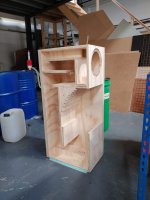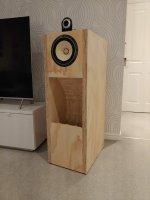Hi all, recently completed another fullrange build and now looking for some advice on how to get the most out of them. I have Fostex FE208E sigma in the factory cabinet with FT17H tweeters crossed at 10k (i think?) and have a bit of budget left to treat them to a decent amplifer. So far I have run them from a basic Marantz AV receiver and a Musical Paradise 6W EL34 tube amp. I was going to go for a Muzishare KT88 amp that can switch between UL and Triode but to my ears the speakers sound better out of the Marantz than the Tubes up to now and the added power seems excessive given the high sensitivity. I have read before than some Fostex drivers are intended for use with higher output impedance but I'm now totally confused with damping factors, amp classes and different ohm ratings on binding posts. The potential is clearly there, spooky imaging and vocals + bass that can shake the floor, just not easy to pick an amp blind. TLDR: has anyone used these or similar drivers and have any advice on what might suit them?
Pics also show them with 208NS but thanks to a kind forum member I was re-united with the proper sigmas 😁
Pics also show them with 208NS but thanks to a kind forum member I was re-united with the proper sigmas 😁
Attachments
Not the best horn for them. There are some fairly easy ticks that improve the driver by ameliorating some of the ringing. The drivers do require significant break-in.
This combo wants an amplifier with highish Rout. Typically SE tube amps but there are a growing number of SS (ie bridged ACA). Som tube push-pull amps also have high Rout, The Zesto just measured by Stereophile showed an unexpectedly high output impedance.
dave
This combo wants an amplifier with highish Rout. Typically SE tube amps but there are a growing number of SS (ie bridged ACA). Som tube push-pull amps also have high Rout, The Zesto just measured by Stereophile showed an unexpectedly high output impedance.
dave
If you want to experiment cheaply, insert a variable resistor in series with the speaker & adjust until you've hit the balance you like best. When you're happy, measure the value, and then you've a few options:
1/ Remove variable resistor & insert a fixed power-resistor of that value (series-parallel a bunch if necessary) to achieve that value, in series with the speaker, run with the Marantz, and leave it at that.
2/ Remove variable resistor & use speaker wire of roughly the same resistance over its loop length. If you're not happy about tiny-gauge copper, womble to the local scientific wire supplier & buy some resistance wire, tungsten wire or similar in a gauge that for the loop length will give you the desired R. Sheath in your choice of tubing, and twist together, pitch depending on the type of wire & how rigid it is.
3/ Look for a quality amplifier with an output impedance of roughly that value that's in budget, or that rarest of devices nowadays -a variable output impedance amplifier
-a variable output impedance amplifier
1/ Remove variable resistor & insert a fixed power-resistor of that value (series-parallel a bunch if necessary) to achieve that value, in series with the speaker, run with the Marantz, and leave it at that.
2/ Remove variable resistor & use speaker wire of roughly the same resistance over its loop length. If you're not happy about tiny-gauge copper, womble to the local scientific wire supplier & buy some resistance wire, tungsten wire or similar in a gauge that for the loop length will give you the desired R. Sheath in your choice of tubing, and twist together, pitch depending on the type of wire & how rigid it is.
3/ Look for a quality amplifier with an output impedance of roughly that value that's in budget, or that rarest of devices nowadays
 -a variable output impedance amplifier
-a variable output impedance amplifiera variable output impedance amplifier
Wonderful things. Got to live with one for awhile.
dave
I actually bought plans for Scott's Vulcan a while back but dont have the space for them at the moment, might do a cheap OSB mockup just to try them in out in the garage. Have been using something called Corian in work recently, looks and feels a bit like stone but can be machined and bonded like acrylic, I reckon the vulcan would look great in faux marble!Not the best horn for them. There are some fairly easy ticks that improve the driver by ameliorating some of the ringing. The drivers do require significant break-in.
Variable resistor sounds like a good bet, very difficult to A/B test the different amps while swapping cables and such around, that should definitely make it easier to hear the effects. Would 0-10ohm, be an appropriate range? Not many amps seem to show output impedance in the spec so hard to know what an upper limit might be. Also am I right in thinking that running the tweeter in parrallel gives me a 4ohm load, so output impedance/ damping factor will have a much greater effect?If you want to experiment cheaply, insert a variable resistor in series with the speaker & adjust until you've hit the balance you like best. When you're happy, measure the value, and then you've a few options:
Cost inflation: 1954 30 W Altec systemMadness that we stopped doing common-sense things like that.
preamp $135, ~ $1,532
amp $159, ~ $1,833
Quite reasonable, but assumes made in same volume, which today would be just a small fraction due to how far technology has come, so 10-20x more for such customs?
Vulcan a while back but dont have the space for them at the moment
Height restrictions. I expect the hooyprint is similar to the Fostex horn.
dave
Agreed -probably all of that and the rest. 😉 You'd think with the expansion of various DIY amplifier modules there might have been some more interest in that quarter though.Cost inflation: 1954 30 W Altec system
preamp $135, ~ $1,532
amp $159, ~ $1,833
Quite reasonable, but assumes made in same volume, which today would be just a small fraction due to how far technology has come, so 10-20x more for such customs?
Hi Tipper,
I coincidently stumbled over John´s Temple Audio amps, and since then I use them for a high-quality FR driver above 300Hz. I had and still have a number of very expensive amps, but the small Temple Audio is staying in the chain. The price is laughable. The music sounds great.
It is no high R-out amp though. The necessary system equalisation must be achieved in other ways, best with a correction filter.
Time to get REW, DATS, Xsim and start to play...
All the best
Mattes
I coincidently stumbled over John´s Temple Audio amps, and since then I use them for a high-quality FR driver above 300Hz. I had and still have a number of very expensive amps, but the small Temple Audio is staying in the chain. The price is laughable. The music sounds great.
It is no high R-out amp though. The necessary system equalisation must be achieved in other ways, best with a correction filter.
Time to get REW, DATS, Xsim and start to play...
All the best
Mattes
- Home
- Loudspeakers
- Full Range
- Amplifiers for Fostex FE208e∑, high sensitivity low impedance


